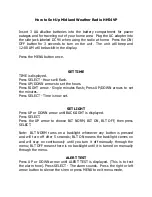
21
20
SUN
- Wireless weather station
SUN
- Wireless weather station
• The indoor temperature will be displayed on the basic station and the basic station will
scan the outdoor temperature and the reception symbol will be flashing.
• If the reception of the outdoor temperature fails, “- -” appears on the display. Check if
there is any source of interference. After the reception of the radio-controlled time you can
start the initialization for the outdoor transmitter manually. Press and hold
▼
button for
3 seconds. The basic station will scan the outdoor temperature.
4.1. Radio-controlled time reception
• The clock will now scan the DCF frequency signal and the DCF symbol will be flashing.
When the time code is received successfully after 3-7 minutes, the radio-controlled time
and the DCF symbol are displayed steadily in the display.
•
Caution:
During the DCF time reception period, backlight turns off and no outdoor tem-
perature will be transmitted.
• If there is no reception possible, manual initialization can be helpful.
• Press the WAVE button.
• The DCF symbol will be flashing.
• Interrupt the reception by pressing the WAVE button again. The DCF symbol disappears.
• The DCF reception always take place at 1:00 o'clock in the morning until 5.00 o'clock. If
the reception is not successfully received at 5:00 o'clock, further attempts will be made
again at 1:00 clock in the morning.
• If the clock cannot detect the DCF-signal (for example due to disturbances, transmitting
distance, etc.), the time can be set manually. The DCF symbol disappears and the clock
will then work as a normal quartz clock. (see: Manual setting of the clock and calendar).
4.1.1 Note for radio-controlled time DCF
The time base for the radio-controlled time is a caesium atomic clock operated by the
Physikalisch Technische Bundesanstalt Braunschweig. It has a time deviation of less than one
second in one million years. The time is coded and transmitted from Mainflingen near Frankfurt
via frequency signal DCF-77 (77.5 kHz) and has a transmitting range of approximately 1,500
km. Changeover from summer time or winter time is automatic. In Daylight Saving Time “DST”
is shown on the LCD. The quality of the reception depends mainly on the geographic location.
Normally there should be no reception problems within a 1,500 km radius around Frankfurt.
Buttons front (Fig. 1)
B1:
Light and snooze button
Buttons back (Fig. 2)
B2:
MODE button
B3:
ALARM button
B4:
▲
button
B5:
▼
button
B6:
WAVE button
B7:
LIGHT/SNZ button
Housing (Fig. 2)
C1:
Battery compartment
C2:
Connecting power supply
C3:
Stand (fold out)
4. Getting started
• Place the basic station and the outdoor transmitter on a desk with a distance of approxi-
mately 1.5 meter. Avoid getting close to possible interference sources (Electronic devices
and radio installations).
• Open the battery compartment of the outdoor transmitter.
• Insert two new batteries 1,5 V AAA into the battery compartment of the outdoor transmit-
ter. Make sure the polarities are correct.
• Remove the protecting foil from the display of the basic station.
• Connect the basic station to the attached power adapter. Insert the adapter into the jack at
the basic station and connect the power adapter to a wall socket.
Important!
Make sure
that your household voltage is 230V! Otherwise your device may be damaged.
• The device will alert you with a beep and all LCD segments will be displayed for a short
moment.
• The backlight is activated permanently.
TFA_No. 35.1133_Anleit_05_17 18.05.2017 15:26 Uhr Seite 11












































